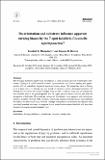Files in this item
Do orientation and substrate influence apparent turning biases by the 7-spot ladybird, Coccinella septempunctata?
Item metadata
| dc.contributor.author | Humphreys, Rosalind K. | |
| dc.contributor.author | Ruxton, Graeme D. | |
| dc.date.accessioned | 2020-05-07T10:30:09Z | |
| dc.date.available | 2020-05-07T10:30:09Z | |
| dc.date.issued | 2020-03-20 | |
| dc.identifier | 267818538 | |
| dc.identifier | ce51b260-c8b7-4e48-8a65-e6276a2d4557 | |
| dc.identifier | 000527815700001 | |
| dc.identifier | 85083503670 | |
| dc.identifier.citation | Humphreys , R K & Ruxton , G D 2020 , ' Do orientation and substrate influence apparent turning biases by the 7-spot ladybird, Coccinella septempunctata ? ' , Behaviour , vol. 157 , no. 3-4 , pp. 205-230 . https://doi.org/10.1163/1568539X-00003587 | en |
| dc.identifier.issn | 0005-7959 | |
| dc.identifier.other | ORCID: /0000-0001-8943-6609/work/73701371 | |
| dc.identifier.other | ORCID: /0000-0001-7266-7523/work/73701874 | |
| dc.identifier.uri | https://hdl.handle.net/10023/19896 | |
| dc.description.abstract | How foraging predators explore their environment is a fundamental aspect of predator-prey interactions. Girling et al. (2007) tested Coccinella septempunctata in a Y-maze, finding that approximately 45% of individuals displayed significant turning biases. We extend the work of Girling et al. in three ways: (1) turning bias was tested on vertical as well as horizontal structures, (2) turning bias was tested on natural Y-shaped twigs as well as artificial twigs and (3) turning bias was recorded both as the pre-designated ‘left’ or ‘right’ physical branch selected and from the perspective of ladybirds. No significant patterns of ‘handedness’ were apparent with vertical orientation, on either substrate. With horizontal orientation, significant turning biases were exhibited on artificial but not natural twigs. Overall, although turning biases are theoretically efficient when searching branched structures, we propose that in natural environments ladybirds will base their foraging movements on environmental cues. | |
| dc.format.extent | 26 | |
| dc.format.extent | 1209762 | |
| dc.language.iso | eng | |
| dc.relation.ispartof | Behaviour | en |
| dc.subject | Handedness | en |
| dc.subject | Foraging efficiency | en |
| dc.subject | Orientation | en |
| dc.subject | Substrate | en |
| dc.subject | Turning bias | en |
| dc.subject | QH301 Biology | en |
| dc.subject | DAS | en |
| dc.subject.lcc | QH301 | en |
| dc.title | Do orientation and substrate influence apparent turning biases by the 7-spot ladybird, Coccinella septempunctata? | en |
| dc.type | Journal article | en |
| dc.contributor.institution | University of St Andrews. School of Biology | en |
| dc.contributor.institution | University of St Andrews. Centre for Biological Diversity | en |
| dc.identifier.doi | https://doi.org/10.1163/1568539X-00003587 | |
| dc.description.status | Peer reviewed | en |
This item appears in the following Collection(s)
Items in the St Andrews Research Repository are protected by copyright, with all rights reserved, unless otherwise indicated.

